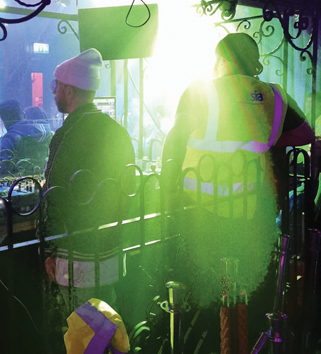The man and woman were in agony. The nightclub had been perfectly normal – the DJ was playing Seventies classics – until the acid attack. The door staff responded quickly and took the worst affected patrons into the kitchen beside the ground floor room where the attack happened, and did the right thing – diluted the affected areas with water from a tap kept running, while taking care not to splash and endanger themselves.
It was, thankfully, not for real; only an exercise, by the Security Industry Authority (SIA), with police and other emergency services observing, for SIA-badged security and other staff to practice their emergency response – not only to a corrosive substance used as a weapon, but a knife attack and marauding terrorist attack outside; all requiring first aid. The exercise – the victims were played by actors – was on an October Sunday evening at The Cuckoo Club in London’s West End (pictured), and featured in the November print edition of Professional Security Magazine (article from page 45, ‘Last night a DJ saved our lives’).
Meanwhile, the first aid charity St John Ambulance with counter-terror police have set out policy around Public Access Trauma (PAcT) First Aid Kits, in the name of ‘first aid resilience’, and ‘survivability’. The idea; whether the attack is by a knife wielded by a criminal or marauding terrorist, victims have more chance of staying alive if they are given immediate and basic first aid, before 999 crews can arrive – which may be some time, if a terrorist incident has been declared.
Hence the authorities are urging PAcT kits to be on business premises, ‘for use by any person regardless of their level of training’, to support the treatment of life-threatening injuries. While under health and safety in the workplace law there is no specific legal duties relating to having in place publicly accessible first aid kits, even before the spate of terror attacks in 2016, the charity citizenAID was founded in 2016, seeking to educate the public about how to improvise treatment before emergency services are available.
The authorities advise that PAcT kits should be in green bags and clearly labelled; and next to other first aid provisions such as defibrillators. They ask besides that staff should know where the kit is, what’s in it, be trained – and where applicable, with accredited training – in the use of the kit. Beyond that, sites should have contingency plans to work out what are the most likely uses of the kit; and a venue should carry out a formal risk-based process to determine the best location for the kit, which may be at an entrance or fire exit or muster point; or in a staff rest room, security control room or already designated first aid room.
More advice is on the UK official Nactso (National Counter Terrorism Security Office) website. That includes ‘You can save a life’ cards that visually detail the recovery position – what to do if a casualty is not responding to you, though breathing; how to stop simple bleeds; and how to stop severe limb bleeding by applying a tourniquet. A ten-page supporting document details what PPE and other equipment ought to make up the kit.
The timing of the official appeal for premises to consider such kits is due to the recent attempted suicide bomb attack outside Liverpool Women’s Hospital; and the murder of Sir David Amess MP.
Separately, bleed control kits were recently used by a police officer who attended a Birmingham stabbing after install by the Daniel Baird Foundation, which has distributed hundreds of the kits across the UK in an effort to stop more lives being lost to knife crime. The Foundation, set up in the name of a man fatally stabbed in the city in 2017, is also delivering training courses.










